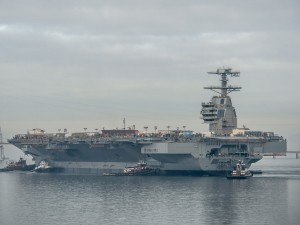2015-01-22 Second Line of Defense visited the next generation carrier CVN 78 (Gerald R. Ford) on January 9, 2015.
We had a chance to interview the Skipper of the ship, Captain John Meier, and afterwards tour the ship with the Captain and senior construction personnel.
We will publish the interview with the Skipper next week, but this week will publish three interviews conducted during the visit that highlight innovations and changes associated with the new class of carriers.
We noted earlier:
The ship is designed as well to allow for a very flexible approach to future innovations.
But the most significant change associated with the ship can only be partially seen in our photos, for the combat systems areas are not photographed nor the new command post areas.
The significant computational power aboard the ship with a very powerful C2 system, new radars with significant capability to support the enhanced C2, plus a very unnoticed innovation whereby flexible command posts can be configured rapidly aboard the ship to support a diversity of missions, all add up to a very different type of carrier.
This carrier can operate much more than as a contribution to a strike mission; and much more as a joint and coalition C2 enabler, and one which could operate to shape a regional engagement force.
It is clear that a key aspect of CVN 78 is its potential role as a very flexible C2 at sea command platform.
The technology inherent in the ship provides for such a possibility, and is discussed with the Skipper of the ship in a separate interview.

But less obvious is the capability to use the physical structure of the ship to put in place a variety of command spaces for USN, joint or coalition forces to come onboard and to work together for exercises or operations.
When visiting the ship, we discussed what the CVN 78 team calls “flexible infrastructure” on board the ship with Chris Howell, Combat Systems Construction Supervisor.
Question: What is flexible infrastructure aboard the USS Gerald Ford?
Howell: There are currently 19 components on the ship that contain flexible infrastructure and flexible infrastructure contains three elements, a deck system, an overhead system, and a bulkhead system.
The deck system and the overhead system are both designed and shipboard qualified by Newport News.
The bulkhead track system uses a commercially available track.
What this has done is given us the flexibility — therefore flexible infrastructure — in designing or layout of the combat command spaces on the ship.
There are one-inch increments in the slotted overhead and deck track.
The overhead is set on two-foot centers and the deck track spacing is on one foot centers.
This allows for infinite flexibility and layout of the space.
We’ve allowed for the layout whether it’s furniture, equipment racks, lighting, and ventilation, anything that would mount in this space can be mounted with bolts.
There’s no welding involved.
There are no hard mounts once it’s put on the track system.
Everything can be reconfigured.
Question: So you can move a variety of equipment into the rooms, and fit the room and the equipment together so to speak dependent on who is using the C2 space?
Howell: That is correct.
It’s not unlike an airliner.
The airliners can adjust the legroom of how many people you want to carry in the plane.
We are using exactly the same concept, but we are doing so with regard to workspace.
One can put chairs or desks or workstations into the space as makes sense for your C2 work area.
There’s another element with that too on the ventilation side, which allows you to cool your electronic equipment.
You’ll notice the two big vent trunks on the starboard bulkhead coming down from the overhead.
This is the supply ventilation trunk that feeds under the deck that is distributed through thermostatically controlled louvers controlled by the ventilation control panel.
The diffusers can be moved around the room. You can actually move the ventilation to blow closer to that heat load.
The return vent system is in the overhead.
There will be louvers in the overhead ceiling tiles that can be reconfigured to pull the heat off of the equipment.
Not only can we cool it from underneath, we’re going to pull the heat out through the overhead.
It’s inherently much easier to change or alter a compartment without having to come into a shipyard for major rework with welding and other hotwork, and it can be done in fairly short order.
Question: How rapidly?
Howell: Recently, the innovation center tested the concept and was able to do a reconfiguration during lunchtime.
The innovation center has a mock up with three rooms like this one to work with.
The cost of the system to build in flexibility is higher up front, but the downstream costs are much less as you can reconfigure onboard the ship without shipyard reconfiguration costs.
Editor’s Note: Huntington Ingalls described flexible infrastructure as follows:
Flexible infrastructure architecture that allows spaces to be adaptable to rapid changes without the use of “hot work.”
It eases compartment reconfiguration to support changing missions, maximizes time for technology development prior to equipment installation, and eliminates cost and schedule impacts associated with the traditional conflicts from rework.
Ford-class technology – Newport News Shipbuilding
For an engineering look at the reconfigurable command spaces approach adopted by the USS Gerald Ford, see the following:

